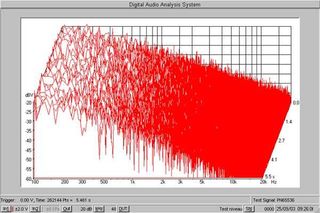Altec Purports Pro Sound with Lansing FX 6021 Speakers
Test Procedure
For the objective tests, we used a DAAS32 (Digital Audio Analysis System) electro acoustic measuring system based on a dedicated reception card and software running under Windows. The measuring microphone was a 1/4" Neutrik 3382. The frequency response used the double measurement principle. A standard measurement taken from a distance suitable for the satellites associated with it gave an approximate measurement for the base. The System software enabled the connection of both measurements after the operator had chosen the right frequency, based on tests performed. This overall measurement was associated with a measurement of the bass only in the cabinet (using the proximity method) which made it possible to clearly see what to expect from the equipment as well as the frequency covered by the satellites.
The graphs shown here have been weighted and traced in thirds of an octave. This sort of curve eliminates occasional accidents of the frequency response but the representation will be much clearer for a non-specialist.
All the tests were performed under conditions that mirrored typical use as closely as possible, the satellites being placed on a desk, and the bass cabinet on the floor. So the result is representative of what you will get in practice, assuming you have installed the system correctly.
For subjective tests, we used a PC fitted with a Creative Audigy 2 ZS Platinum Pro sound card. The music that we listened to was varied so as to demonstrate the kind of sound reproduction you can expect as well as any defects in the principal registers. The media we used were audio DVDs and audio CDs.
These tests were completed using an assessment of the maximum possible sound level obtainable without audible distortion. The test was performed using a signal created from broadband pink noise energy-filtered in the infra-bass (unlikely to be present in most types of music) and filtered in a fairly soft low-pass from 500 Hz (-3 dB).

This third-of-an-octave analysis of our test signal gives you an exact picture of the distribution of the frequencies transmitted to the speakers.

This 3D spectrum analysis (level, frequency and time in 5.5 s) will give you an idea of what our signal sounded like.
Stay on the Cutting Edge
Join the experts who read Tom's Hardware for the inside track on enthusiast PC tech news — and have for over 25 years. We'll send breaking news and in-depth reviews of CPUs, GPUs, AI, maker hardware and more straight to your inbox.
Level was measured at a distance of 40 inches (1 meter), using speakers installed in a typical configuration (satellites on a desk, bass cabinet on the floor) and with a sound meter offering a resolution of 0.1 SPL dB, configured with a "Long" standardized response time so as to obtain a stable value, representative of the average level obtained. The value obtained was, of course, expressed in SPL (Sound Pressure Level) dB, without weighting.

The sound level shown on the screen of our sound meter was obtained in SPL dB, with "L" for linear.
Most Popular

